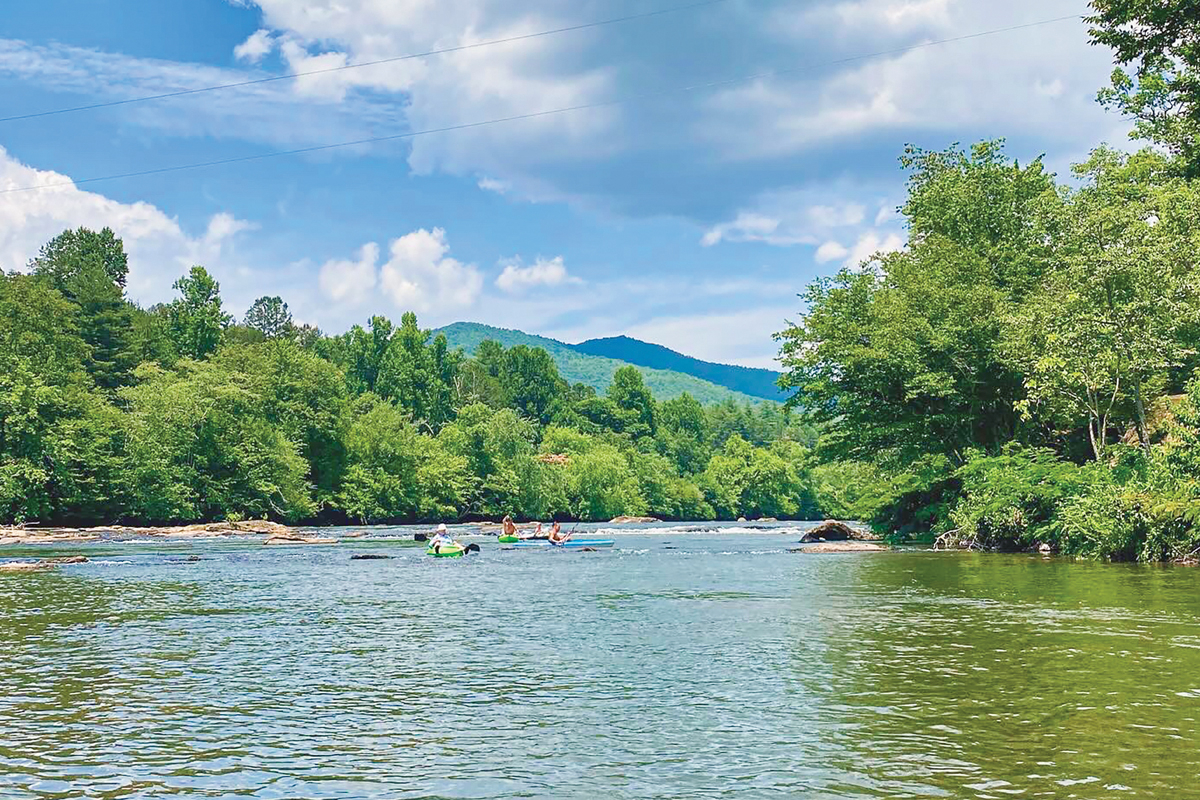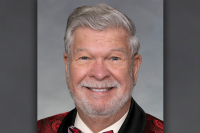Macon County floodplain ordinance debate heats up
 Rivers in Western North Carolina, although normally peaceful, are prone to flash flooding. Hannah McLeod photo
Rivers in Western North Carolina, although normally peaceful, are prone to flash flooding. Hannah McLeod photo
A proposed change to Macon County’s floodplain regulation has prompted outcry from the public and rippled across the county government.
The floodplain is made up of two parts — the floodway, also known as the non-encroachment area, and the flood fringe which extends from the floodway to the flood line. Discussion about updating the current regulation started in March when Commissioner Josh Young proposed changes to the county’s flood damage prevention ordinance.
One of the proposed changes would allow property owners in the flood fringe to put 25% fill on part of their property. But Young’s ownership of property in the area raised questions about his motives for the proposal. He said he has deed restricted his land so he will not benefit from the proposal.
“I actually sought legal counsel to go ahead and deed restrict that property I purchased just to show good faith,” Young said at the May 14 meeting. “That’s happening, that property will never be filled, so that discussion’s over with, there’s no need to worry about that. There’s no need to worry about me profiting from this role sitting up here. That bug’s squashed.”
However, the restriction is not yet recorded at the Register of Deeds. Young’s attorney, Russell Bowling, said the deed restriction process started in March when the property was purchased.
“He requested that I put a deed restriction on the property he owns, consistent with the fill restrictions in place when he purchased the property,” Bowling said.
Related Items
Bowling also executed Young’s purchase of the property. Bowling said the process has been slow because his office is understaffed.
At the June commissioners meeting, Director of Planning and Code Enforcement Joe Allen explained how the 25% fill functions.
“So if you have a 5-acre parcel and an acre of it was in the flood fringe, you would be allowed to fill .25 — a quarter of an acre,” Allen said.
Under the earlier ordinance, a property owner could not put fill dirt in any part of the floodplain. Young called the proposal, which will be open for public comment on July 9, a compromise.
“We have decided to take a baby step towards a compromise. I feel like this is not going to make either side of the topic happy,” Young said via email on July 1. "At this point I feel like this is going to allow people to access, restore and use properties as desired without mass fill."
Young said his move followed complaints from members of the public about the existing ordinance, as well as the soil erosion and sedimentation control and water supply watershed protection ordinances.
“These are not things that I pulled out of thin air, these are real issues that people in the public, people in the community, have come to me about over the years,” Young said at the May county commission meeting. Other commissioners also said they had heard questions from the community about the ordinance.
Federal compliance with the floodplain management ordinance is required in order for citizens in North Carolina's counties and towns to be eligible for federal flood insurance through the NFIP and FEMA.
The North Carolina Model Flood Damage Prevention Ordinance provides guidelines for North Carolina towns and municipalities to pass their own regulations that align with the federal requirements.
The updated flood damage prevention ordinance would allow property owners to fill in a percentage of the flood fringe of the property. County Planner Caleb Gibson explained that NCDEQ guidelines allow municipalities to opt for as much as 100% of a property to be filled outside the floodway, or the non-encroachment area in a flood damage prevention ordinance.
“North Carolina pretty much mirrors what FEMA does,” said Gibson. “So we’re [Macon County] still a little bit more restrictive than what the state allows. So that’s a good thing.”
Property on the line
Young purchased three properties along the Georgia Road, all of which are at least partially in the floodplain, on March 7 of this year. The properties are held by Steele LLC, an entity formed in September 2023 operated by Young and his wife. The properties were purchased from Wanda Stamey and James Martin.
Young repeatedly claimed that he restricted the properties so they will not be subject to changes in the floodplain ordinance.
“Yes, I do own properties in the flood plain, and as noted, we have deed restricted to the current regulation,” Young said in his July 1 email.
On Tuesday, Young explained that he made the request of his attorney. No restriction is recorded at the Macon County Register of Deeds, and Bowling said the restriction is in progress.
Subcommittee recommendation
In May, the county’s planning board recommended the ordinance change to the full board of commissioners.
After the recommendation, commissioners decided to create a subcommittee to further investigate the recommended changes and speak to people on both sides of the issue.
“I would make a suggestion here, choose a couple planning board members, a couple commissioners, bring people like Lewis [Penland] in, bring people from the other side in,” Director of Planning and Code Enforcement Joe Allen suggested.
The board appointed Young and fellow commissioner Danny Antoine, along with planning board members Barry Breeden and Larry Lackey, to the subcommittee.
Despite creating the subgroup, commissioners did not confer in the meetings with the people outside of county and state administration.
Aquatic biologist Bill McLarney, whose name was suggested as an expert to be consulted at the May meeting, said he was never contacted by a member of the committee or given an opportunity to share insights on the floodplain ordinance.
“I am not happy about the level of transparency at this point,” McLarney said at the June meeting.
The subcommittee did meet with NC Flood Mapping management, Allen confirmed, before sending its recommendations for the new ordinance to the commissioners. A few weeks later, Allen resigned from his position, and his last day was Friday, June 28. Allen did not respond to a request for comment about why he resigned.
The board is scheduled to vote on the new ordinance at its July 9 meeting.
‘Duty to vote,’ financial interest and ethics
The fact that Young owns floodplain property raised questions for community members during the last month’s meetings. Otto resident Sarah Johnson asked about the property at the May commission meeting.
“We also respectfully and politely ask that Commissioner Young recuse himself from any decision-making process on this matter to avoid any semblance of impropriety, however perceived,” Johnson said during the meeting stating the name of Young’s LLC, Steele NC.
According to the Macon County Commissioner’s ethics policy, a commissioner can’t use their position, county facilities or resources for private gain. A commissioner needs to disclose any interest, or that of an immediate family member in a public meeting under the policy.
Young has repeatedly stated that he will not benefit from the updated policy.
The county policy provided that the board will decide if the council member needs to withdraw from any consideration in the matter, but state law requires county or municipal leaders with vested interest in a vote not to take part in the consideration, according to Crista Curccaro, professor of public law and government at the UNC School of Government.
Curccaro has led state-mandated training for commissioners from across the state where they learn about their obligations as public officials.
“We talk about the sort of duty to not act in private interests,” Curccaro said.
Under state law, if an official has a “direct, substantial, and readily identifiable” financial interest in a matter, then the elected official cannot vote on the issue, she said.
The statute also specifically identifies rezoning and zoning issues as matters where officials with a business interest or a familial interest cannot vote.
“If we have an instance where we've got that prohibited conflict identified in the statute, then the board member cannot vote. They would be prohibited by law from doing so,” Currccaro said.
She explained that while votes might have some personal effect for officials, they need to consider the continuum of impact that would make them ineligible to vote. For matters affecting the entire community, like a vote to assess property taxes, board members may vote.
Beyond state law, the county requires commissioners to disclose potential conflicts of interest. A member “shall publicly disclose on the record in open meeting the nature and extent of such interest and shall withdraw from any consideration in the matter if excused by the council,” the policy stated.
“And so the way I interpret that is this board member has to speak to it in a public meeting,” said Currccaro.
Young explained that he did own property on Georgia Road at the May county commissioners meeting, and was recording the deed restriction.
Debating what to do in an area prone to flooding
The floodplain provides a natural regulation of the river during heavy rains and flash floods that happen in the mountains. The prior ordinance, enacted following severe flooding in 2004 when two 500-year floods occurred along tributaries of the Little Tennessee River, prohibited any imported dirt from being brought into the floodplain. The 2004 flooding also led to the Peeks Creek disaster in which six people died following a massive landslide.
This is not the first time this issue has surfaced in Macon County. In 2013, the county considered a change to the ordinance after representatives from Wells Grove Baptist Church complained that they could not use fill dirt to expand its parking lot into the floodplain, The Smoky Mountain News reported.
North Carolina law gives the power to set up flood ordinances to the local government, but it provides a model ordinance to help write those laws. The model ordinance guideline allows fill outside of the floodway, Gibson explained. The new ordinance focuses on adding fill to the flood fringe.
“We’re still more conservative than what the North Carolina guidelines are,” Gibson said. “So I’m hoping that it’s not going to affect the county in any way or the Little Tennessee.”
Kevin McCaskill of Macon County Farm Bureau told commissioners at the June meeting that he has seen more floods in the last 25 years causing more emergency situations for those in the floodplain. Beyond safety, McCaskill said he does not want to see the floodplains developed.
“The most productive farmland that we have is the bottomlands of this county; we don’t have a great deal of it, and in North Carolina, we are losing farmland faster than any state in the nation,” McCaskill said.
North Carolina is the second fastest state being developed, according to a 2020 report by the American Farmland Trust.
Allen told county commissioners the new ordinance is a compromise.
“In my opinion, these are middle of the road changes,” said Allen. “We’re not turning people loose to mass fill without proving in some wat that it’s not going to hurt anybody. But it does allow some freedom for small sections of fill.”
Allen said that if people wanted to do mass filling, they would have to prove to the county with a hydraulic engineer study that the fill wouldn’t have any effect on the floodplain.
“These changes are modeled off the City of Brevard and Henderson County ordinances,” Allen said. “It’s a little of mix in both of those ordinances together and how they handle fill in those jurisdictions.”
Gibson also said county leaders examined policies in the surrounding counties to determine an appropriate fill amount.
“[Other towns were] using that 25%. Everybody kind of went down the middle and agreed that’s a good idea to start within this,” Gibson said.
The proposed changes to the ordinance allow property owners to add more than 25% fill, but before they do so, they must obtain a “no adverse impact study” from an outside engineer.
“What that means, they’re going to come out there and make sure that whatever fill dirt they’re adding will not raise the water level during the flood and will not hurt neighboring properties,” Gibson said. “The engineer comes and does that.”
There isn’t a limit to how deep the 25% percent of fill would be.
“The way that I view it is, if you are filling above what we call the base flood elevation (BFE) whether you are filling it 6 inches above that level or 6 feet above that level, that water is not going; you still displaced that water,” Allen said.
According to Allen, the proposed changes to the ordinance were reviewed by the county attorney, as well as the state’s Floodplain Mapping Program, which approved the proposed changes and affirmed that they are within FEMA guidelines.
“As long as we enforce the ordinance the way we have it proposed to be written we’re not going to face any repercussions from state floodplain mapping guys or FEMA,” Allen said.
At the June meeting, concerned resident Angela Faye Martin spoke about the need to keep the Little Tennessee River from fill that would end up in the water.
“Freedom to me means being able to put my boat in the Little Tennessee River and have future generations know that we protected their right to put a boat in the Little Tennessee River and be able to make a dinner of redeye bass, fry it up in cornmeal batter when they get home. Redeye bass cannot live in a silted upriver,” Martin said during the meeting.
Aquatic biologist McLarney, who has been studying the Little Tennessee River watershed for 40 years, spoke against the change.
“It is somewhat unique, and certainly in the southern Blue Ridge, the Little Tennessee is the healthiest major river we have,” McLarney said. “It’s home to a number of species which have been wiped out in other places and which in some cases are being restored.”
According to McLarney, the flood damage prevention ordinance as it is currently written focuses on avoiding damage of all kinds to the natural environment, but also to property, loss of life and unnecessary expense.
“It was a very well-researched, meticulously put together ordinance, as opposed to the somewhat minimal requirements that the state has,” McLarney said.
One property owner looking to fill a small portion of their land is unlikely to have an engineer look at the situation and demonstrate any potentially damaging rise in water levels, McLarney said. He said he is more concerned about the cumulative effect of changing the regulation.
“It adds up,” he said. “And the same engineer looking at the same numbers in aggregate will be able to say that is going to cause alterations to flow that are potentially damaging.”
Chuck Grant from Nantahala told commissioners that not being able to use floodplain land is a violation of an owner’s property rights.
“You have a bundle of rights that belong to your property. One of those is the right to quiet enjoyment. That means that you can use your property as you see fit and so under this exclusion zone you can’t use this property. That just doesn’t seem right to me,” Grant said at the June meeting.
Commissioner Paul Higdon said he thinks the property should be able to be used in an undeveloped way such as for camping. Commissioner John Shearl also mentioned campgrounds as an option for development along the river at the May 14 meeting. He said he previously owned a campground.
“Campgrounds are designed. When I go camping, I want to be on the river, I want to be on the creek, but if you can’t have one, where do we go?” Shearl asked in May.
A number of community members cited recent flooding tragedies such as the Peeks Creek disaster and Laurel Bank Campground where four people were killed in 2021 as reasons that camping shouldn’t be encouraged in the floodplain.
The county will hold a public hearing on the flood damage prevention ordinance on July 9. Commissioners also proposed changes to the soil erosion and sedimentation control and water supply watershed protection ordinances. There will be separate public hearings held for those ordinances at the same meeting.













